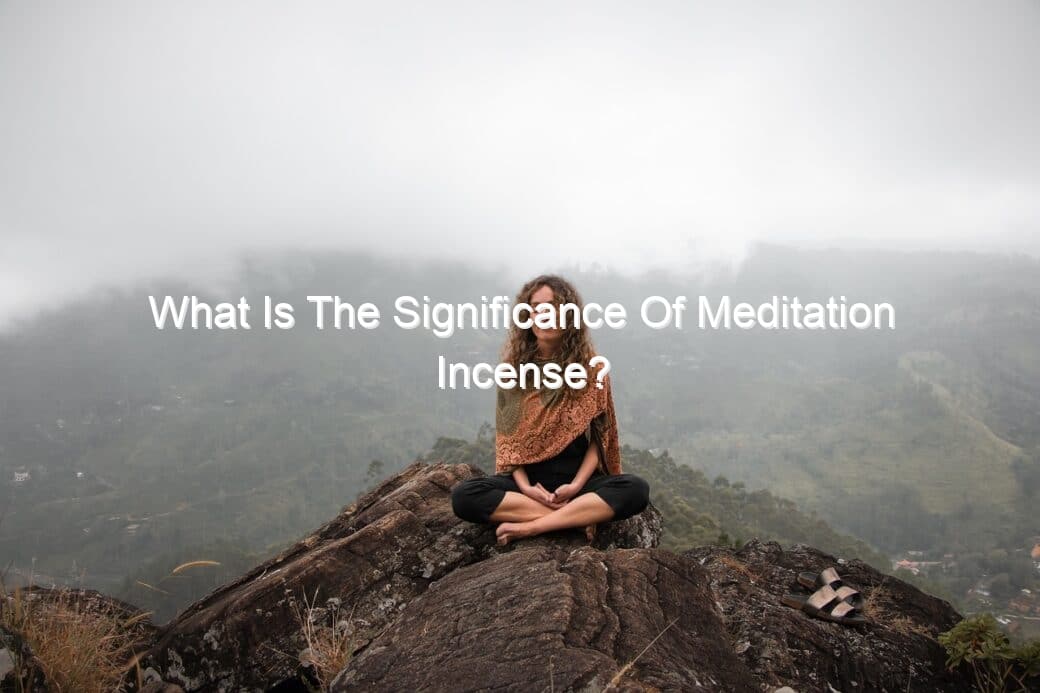If you’re seeking to enhance your meditation experience, you may have wondered if using incense is beneficial. Well, you’re in the right place to find out! This article explores the age-old question: is incense generally considered good for meditation practice? We’ll delve into the potential benefits and drawbacks of using incense during meditation, providing you with valuable insights to help you create the perfect atmosphere for your practice. So, let’s dive right into the aromatic world of incense and its connection to a peaceful state of mind.

Incense Good For Meditation: Understanding the Role of Incense in Meditation
The tradition of using incense in meditation
For centuries, incense has played a significant role in different cultures and spiritual practices, including meditation. The tradition of using incense during meditation dates back to ancient times. It has been an integral part of various religious and spiritual rituals, symbolizing purification, unity, and deepening one’s spiritual connection.
The symbolic significance of incense in meditation
Incense holds symbolic significance in meditation. Its fragrant smoke is believed to represent the transformation of the physical into the spiritual, purifying the space and creating a harmonious environment for reflection and contemplation. The rising smoke also symbolizes the aspirations of the practitioner ascending to the divine or higher realms of consciousness. The scent of incense has the power to evoke a sense of tranquility, aiding in the journey inward towards mindfulness and enlightenment.
Benefits of Using Incense for Meditation
Concentration and focus enhancement
One of the primary benefits of using incense during meditation is its ability to enhance concentration and focus. The pleasant aroma of incense can draw your attention to the present moment, enabling you to stay more focused on your breath or chosen point of focus. The soothing scent creates a stimulating environment that helps declutter the mind, allowing you to dive deeper into your meditation practice.
Aid in stress reduction
Incense has been known to have calming properties that can help alleviate stress and anxiety. The subtle fragrance triggers the brain’s relaxation response, releasing tension and promoting a tranquil state of mind. As you inhale the fragrant smoke, you can feel the stress melting away, making it easier to achieve a meditative state of calmness and serenity.
Promotion of mindfulness
Mindfulness is a key aspect of meditation, and incense can assist in cultivating this state of present moment awareness. The aroma of incense acts as an anchor, allowing you to redirect your attention to the here and now. By consciously breathing in the scent and immersing yourself in its fragrance, you can enhance your mindfulness practice and develop a deeper sense of connection to the present moment.
Influence of Incense on Meditation Environment
Creating a sacred or special meditative space
Using incense during meditation helps create a sacred or special space for your practice. The act of lighting incense signals the beginning of your meditation journey, marking a transition from the ordinary to the extraordinary. The aromatic smoke fills the air, transforming your surroundings into a haven where you can disconnect from the outside world and delve into your inner self.
Stimulation of senses for a holistic meditation experience
Incorporating incense into your meditation routine stimulates the senses, adding an extra dimension to your practice. The scent of incense engages the olfactory system and can evoke specific emotions or memories, heightening the overall sensory experience. The visual aspect of watching the delicate plumes of smoke dance in the air and the gentle crackling sound as the incense burns can also contribute to a more immersive and holistic meditation experience.
Enhancing the mood for meditation
The atmosphere in which you meditate can greatly influence the quality of your practice. Incense has the power to set the mood and create a serene and tranquil environment conducive to deep meditation. The aromatic fragrance helps to calm the mind, uplift the spirit, and create a sense of sacredness. The familiar scent of incense can even trigger a conditioned response, signaling to the mind and body that it is time to relax and enter a meditative state.
Common Types of Incense Used in Meditation
Sandalwood incense and usage
Sandalwood incense is one of the most popular types used in meditation. Known for its warm and woody aroma, sandalwood has been used for centuries in spiritual practices due to its grounding and calming properties. It helps create a peaceful ambiance that enhances focus and deepens meditation.
Frankincense incense and usage
Frankincense incense, derived from the resin of the Boswellia tree, has been highly valued for its sacred and therapeutic properties. Its rich and resinous scent has a deeply calming effect and is often used in meditation to aid in relaxation and contemplation. Frankincense incense is believed to purify the surroundings and promote spiritual connection.
Sage incense and usage
Sage incense, particularly white sage, is commonly used for smudging and purifying spaces. It has a strong and earthy aroma that is believed to cleanse negative energy, making it an ideal choice for meditation. The scent of sage can help create a sacred environment and clear the mind, allowing for a deeper focus during meditation.
Nag Champa incense and usage
Nag Champa incense is a blend of fragrant flowers, spices, and resins. Originating from India, it has a distinctive sweet and musky scent that is widely recognized and appreciated. Nag Champa incense is often used in meditation to create a serene atmosphere and induce a meditative state. It is believed to enhance spiritual experiences and transcendental meditation practices.
Scientific Evidence Supporting the Use of Incense in Meditation
Research on incense’s effect on brain activity
Scientific studies have been conducted to explore the effect of incense on brain activity during meditation. It has been found that certain fragrances, such as sandalwood, can have a calming effect on the brain, promoting relaxation and reducing mental agitation. The inhalation of these fragrances activates specific areas in the brain associated with emotions and attention, facilitating a meditative state.
Studies on physiological effects of incense
Research has also shown that the use of incense during meditation can have physiological benefits. The inhalation of incense smoke has been found to lower heart rate and blood pressure, indicating a decrease in stress levels. Additionally, the calming aroma of incense has been linked to the release of endorphins, which can contribute to a sense of well-being and relaxation.
Alternatives to Incense for Meditation
Essential oils for meditation
If incense is not suitable or preferred for meditation, essential oils can be a viable alternative. Essential oils derived from plants have similar calming and soothing properties as incense. They can be used in a diffuser, applied topically, or inhaled directly to create a fragrant and therapeutic environment for meditation.
Use of sound for meditation
Sound is another powerful tool that can enhance a meditation practice. Playing soft, soothing music, using singing bowls, or listening to guided meditation recordings can help create a serene and immersive atmosphere. Sound vibrations can help to focus the mind, deepen relaxation, and assist in achieving a meditative state.
Visualization techniques
Visualization techniques can also be used as an alternative to incense. Instead of relying on a physical scent, you can mentally visualize a serene and peaceful setting during meditation. Guided imagery practices where you imagine a calming scene, such as a beach or a forest, can help create the desired atmosphere without the need for external fragrances.
Possible Health Risks of Using Incense in Meditation
What science says about health issues related to exposure to incense smoke
While incense is generally considered safe for use during meditation, it is essential to be aware of potential health risks, particularly concerning exposure to incense smoke. Scientific studies have indicated that prolonged exposure to incense smoke in poorly ventilated areas may increase the risk of respiratory problems, such as asthma and bronchitis, especially in individuals with preexisting respiratory conditions.
Tips for safe use of incense during meditation
To minimize potential health risks, it is recommended to use incense in well-ventilated areas or outdoors. Ensure that your space has proper airflow, allowing the smoke to dissipate. It is also advisable to choose high-quality incense made from natural ingredients to reduce the potential inhalation of harmful chemicals. Lastly, if you experience any discomfort or adverse reactions while using incense, it is advisable to discontinue its use and consult a healthcare professional.
Choosing the Right Incense for Your Meditation Practice
Considerations for personal preferences
Choosing the right incense for your meditation practice is a personal decision that depends on individual preferences. Experiment with different fragrances and find the scents that resonate with you. Some people may prefer floral scents like lavender or rose, while others may find earthy or resinous fragrances more appealing. The important thing is to select incense that enhances your meditation experience and promotes a sense of relaxation and tranquility.
Tests for quality in incense
When selecting incense, it is important to ensure its quality to maximize its benefits. Look for incense made from pure and natural ingredients, free from synthetic fragrances or additives. High-quality incense should have a consistent burn rate and emit a fragrant aroma without any unpleasant or harsh undertones. Reading product reviews or seeking recommendations from trusted sources can also help in identifying reputable brands.
Approaches to pairing incense with meditation types
Different meditation practices may benefit from specific types of incense. For example, if you are engaging in a grounding or root chakra meditation, earthy scents like patchouli or vetiver can be suitable. For practices focusing on transcendence or spiritual connection, fragrances such as sandalwood or frankincense may be more appropriate. Experimenting with different combinations and observing how specific scents align with the intention of your meditation can help enhance the overall experience.
How to Properly Use Incense in Meditation
Step-by-step guide to burning incense
To properly use incense in meditation, follow these simple steps:
- Ensure that your meditation space is well-ventilated.
- Place the incense stick or cone in a suitable incense holder or burner.
- Light the tip of the incense with a match or lighter.
- Allow the flame to burn for a few seconds, then gently blow it out, leaving a glowing ember.
- Place the incense holder in a safe and stable location, away from flammable objects.
- Observe the gentle wafting of the fragrant smoke and let it fill the room.
Safety precautions during use
When using incense, it is important to prioritize safety. Here are some safety precautions to consider:
- Never leave incense unattended while it is burning.
- Keep incense away from flammable objects, including curtains, paper, or other materials.
- Do not place lit incense near children or pets.
- Ensure that the incense holder is stable to prevent it from tipping over.
- Extinguish the incense fully after use by dipping the burning end in water or sand to ensure there is no risk of any remaining embers.
Maximizing the benefits of incense in your meditation routine
To maximize the benefits of using incense in your meditation routine, ensure that it complements your overall practice. Select scents that align with your intentions and preferences. Create a regular meditation schedule that incorporates incense as part of your ritual. Allow yourself to truly immerse in the sensory experience, taking in the aroma, and letting it guide you into a state of deep relaxation and mindfulness.
Inspiration from Different Cultures and Traditions
Buddhist use of incense in meditation
In Buddhism, incense holds a significant place in meditation practices. The burning of incense is seen as a means to purify the mind and create a sacred atmosphere that enables practitioners to deepen their focus and concentration. The subtle fragrance pervading the meditation space evokes a sense of reverence, aiding in the practitioner’s spiritual journey.
Hindu rituals around incense and meditation
Incense has been an integral part of Hindu rituals for centuries. In Hinduism, incense symbolizes the offering of prayers and represents the presence of the divine. The fragrant smoke is believed to carry the devotee’s prayers and aspirations to the gods while purifying the atmosphere. By incorporating incense in meditation, Hindus seek to establish a deeper connection with their chosen deities and invite blessings into their lives.
Chinese traditional practices
In Chinese culture, incense has a long history and plays a vital role in various traditional practices. From Taoist rituals to Confucian ceremonies, the burning of incense is a way to pay respects to ancestors, seek spiritual guidance, and foster a sense of harmony between the physical and spiritual realms. The gentle aroma of incense is believed to attract benevolent spirits and cultivate inner peace and balance.
In conclusion, incense is widely considered a valuable aid in meditation practice. Beyond its ritualistic and symbolic significance, incense offers tangible benefits such as enhancing concentration, reducing stress, and promoting mindfulness. The choice of incense and its proper use can greatly influence the meditation environment, creating a sacred space and stimulating the senses for a holistic experience. While there may be alternative options for those who prefer not to use incense, its longstanding tradition and scientific evidence supporting its positive effects make it a valuable tool for those seeking a deeper meditation practice. So, whether you choose sandalwood, frankincense, sage, or any other fragrant variety, let the subtle aroma of incense accompany you on your meditative journey to inner peace and self-discovery.




